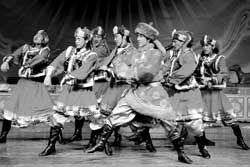
Buri Gude, the groom (front), dances with his friends before setting off for the bride's home.
This month is a good time to visit north China's Inner Mongolia Autonomous Region. The climate turns mild and the vast grassland looks serene, prosperous and enchanting. Now there is another reason. A new song and dance spectacular, "Mongolian Wedding Ceremony," has been winning rave reviews from thousands of visitors.
The show is a condensed version of a three-day ceremony, which dates back to the time when Gengis Khan was the most powerful ruler in the world.
Organizers already plan to take the wedding show to the United States next year and it will travel to Shanghai next month.
The 90-minute show starts with the classic "long-tune" melody, or changdiao and the wedding preparations are made to the sound of the rhythmic beat made by huge boots and dairy bucket drums. Buri Gude, the well-dressed groom, receives wedding gifts from his friends. The "five necessities of a Mongolian man" include the lasso pole, an engraved saddle, an embroidered saddlebag and a bow and arrow. There is also the matouqin, a Mongolian stringed instrument with a scroll carved into a horse's head.
Women are busy making appetizing milk tea and roasted mutton. Musicians either play the traditional eagle flute or chant humai, or the throat-singing in which one person produces at least two tunes at one time.
Girls perform the soft dish dance around the groom, who later joins them in a passionate chopstick dance. Then the wedding begins.
All people offer sacrifices to gods and ancestors in a sacred ritual.
The groom then leads his friends to fetch the bride.
As their number declines and many nomads resettle into towns and cities, many of the original nomadic customs are fading out. The show hopes to preserve these traditions.
Mongolian Wedding art director and gala's producer Cha Gan, spent two years researching the project in an effort to create the most authentic show he could.
Cha Gan, a Mongolian himself, said his people were scattered across the hinterlands of Asia and the wedding ceremony of various tribes are generally very similar but still, there are some details which differ. He visited families across the autonomous region and also in the bordering provinces like Qinghai and Gansu to collect first-hand materials of authentic folklores.
"A conventional Mongolian wedding usually lasts three days and we have the challenge to incorporate them into a one-and-a-half-hour plot and make all the elements blend in harmony," he said. "Some even contradict each other."
For instance, camels would normally appear as the bridal dowry at a wedding in the northern Alxa League. The place is well known for the marvelous Badain Jaran Desert and camels are vital.
However in the neighbouring Erdos, camels are totally forbidden at a wedding. The city is famous for its high-quality wool products and its rolling grasslands. A camel at a wedding, like most weddings around the world, would be a very unusual and scary sight.
"Even though, we really want to create a classic Mongolian wedding that takes on varieties of looks," Cha Gan said.
Audiences discover the rigorous toasting rules obeyed by the Mongolians in Qinghai, and the touching moment when the bride takes away a bag of soil before leaving home. This is the custom of Erdos people.
In scene two, the groom and his team arrive at the bride's home. Six married women stop them from fetching the bride. The groom's team respond by presenting gifts. These women each hold a pipe bowl and look tough.
This comic tradition is common in every Mongolian wedding but only women in the Kerqin District carry a pipe around.
At the end of the wedding, the hostess invites an audience member as the distinguished guest to lift the bride's red veil. It is rather an adoption of the Han custom, which proves a sign of exchanges between the two ethnics.
"All the singing and dancing is indeed amazingly impressive," said Huang Xiaodong, a tourist from South China's Guangdong Province, after watching the show at the Inner Mongolia Xincheng Hotel in Hohhot, the capital city.
The show is staged at the hotel every night and finishes on October 7.
Huang was lucky to catch the horsewhip thrown by the bride. He stepped on to the stage and unveiled the bride.
The groom toasts him three bowls of the local alcohol, which made him a little bit dizzy.
"It is much easier to accept these customs this way than to read from some tourist handbook," Haung said. "What impresses me much is that performers have made full use of the intervals to introduce the dynamic Mongolian life. I have learnt what areas these gorgeous and delicate hand-made costumes represent, what a zhamayan, the unbelievable royal feast, looks like, how to toast and present hada, and to name a few.
The show will make its national debut at this year's Shanghai International Art Festival from October 18 to November 18.
Cha Gan reveals that the English version of the gala is due next May. And it will be on stage in Chicago for a month in June.
(China Daily August 17, 2006)
|

